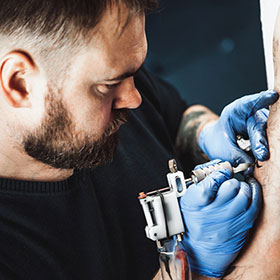No, you should not tattoo over a scab. It can cause infection and ruin the tattoo.
Tattooing over a scab is a risky idea. Scabs form as part of the body’s natural healing process. They protect wounds from bacteria and other harmful elements. Tattooing over a scab can disrupt this process. It can lead to infections, scars, and an uneven tattoo.
It may also cause more pain and discomfort. It’s best to wait until the scab heals completely. This ensures the skin is ready for new ink. Patience will help you achieve a beautiful and safe tattoo. In this blog, we will explore the reasons why tattooing over a scab is not recommended. We will also discuss the steps to take for proper healing before getting a new tattoo.
Tattooing Over A Scab
Tattooing over a scab can be painful. The skin is already damaged. Tattoo needles can cause more harm. This can lead to infections. The ink might not stay well. The tattoo may look uneven. Healing can take longer. It’s best to wait until the scab is gone.
The healing process is very important. Clean the tattoo gently. Apply a thin layer of ointment. Keep the tattoo out of the sun. Do not pick at the scab. Let it fall off naturally. Drink lots of water. Eat healthy foods. This helps your body heal faster.
Expert Opinions
Most tattoo artists advise against tattooing over a scab. Scabs indicate healing skin. Tattooing over it can damage the skin more. This might lead to infections. It can also ruin the tattoo design. Artists prefer working on clear, healthy skin. They want the best results for their clients.
Dermatologists also warn against tattooing over a scab. Scabs protect healing wounds. Breaking them can cause more skin issues. There is a higher risk of infections. The ink might not settle well. This can lead to poor tattoo quality. Always wait until the scab falls off naturally. It ensures your skin is ready for a tattoo.
Risks Involved
Tattooing over a scab can lead to serious problems. The scab is a wound. Tattoo needles can push bacteria into the skin. This can cause a bad infection. Redness and swelling are common signs. Sometimes, pus may come out. This can cause pain. It’s better to wait until the scab is gone.
Scabs protect healing skin. Tattooing over them can damage this skin. This may cause scarring. The tattoo can also look bad. Lines may not be even. Colors may not blend well. Waiting for the scab to heal can help avoid these issues. Patience leads to better results.
Impact On Tattoo Quality
Tattooing over a scab can cause uneven ink distribution. The scab disrupts the surface of the skin. This leads to blotchy or patchy areas. The tattoo may look less sharp and clear. It’s best to avoid tattooing over scabs. Let the scab heal first.
Tattooing over a scab can affect color retention. The scab can block the ink from entering the skin. This can result in faded colors. Over time, the tattoo may lose its vibrancy. It’s important to wait until the scab heals completely. This ensures the best color quality.
Alternatives To Tattooing Over Scabs
Waiting for the scab to heal is the best option. Fresh skin can take ink better. The risk of infection is lower too. Patience now can save you from problems later.
Use ointments to help the scab heal faster. Keep the area clean and dry. Avoid picking or scratching the scab. It can cause scars and delay healing. A well-healed skin is better for new tattoos.
Proper Aftercare
Tattooing over a scab can cause complications and affect the design. Proper aftercare helps ensure the tattoo heals well. Always wait for the scab to fall off naturally before getting any touch-ups.
Cleaning Techniques
Gently wash the area with mild soap and water. Pat dry with a clean towel. Never rub. Use a clean cloth each time. This keeps the area free from dirt. It helps prevent infections.
Moisturizing Tips
Apply a thin layer of unscented lotion. Do this twice a day. Avoid heavy creams. They can clog pores. Keep the scab soft. This aids in healing. It reduces itching too.
Signs Of Healing Problems
Redness around the tattoo can be a sign of infection. Look for swelling and warmth in the area. Pus or yellow fluid is a warning sign. If the tattoo smells bad, it’s not healing right. Itching and pain are normal, but watch for severe cases. Fever could mean an infection in the body.
Scabs should heal in a week or two. Large, thick scabs need more time. If scabs stay longer, there might be a problem. Cracking scabs can slow healing. If a scab gets knocked off, it can harm the tattoo. Healthy scabs should be small and not too thick. Thin, flaky scabs are good signs.
When To Consult A Professional
Before tattooing over a scab, seek your tattoo artist’s advice. They can assess your skin condition. Tattoo artists have experience with healing. They know when it’s safe to proceed. Scabs can hide infections. This can lead to complications. Trust their expertise for best results.
Sometimes, it’s best to see a doctor. Infections can look like scabs. A doctor can check this. They can give proper treatment. This will ensure your safety. Always prioritize your health. Listen to professional advice.
Conclusion
Tattooing over a scab is not a good idea. It can lead to infections. It may also ruin the tattoo’s appearance. Always wait for the skin to heal fully. Consult with a professional tattoo artist. They will provide the best advice.
Patience ensures a better and safer tattoo experience. Healthy skin is the best canvas for your art. Your tattoo will look better and last longer. Take care of your skin first. It is worth the wait.

